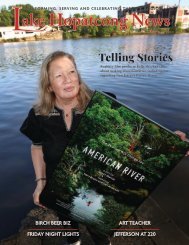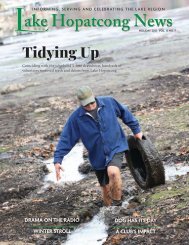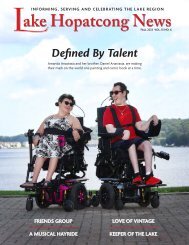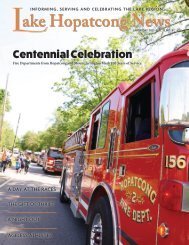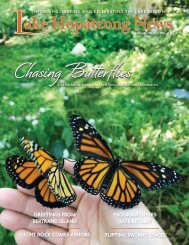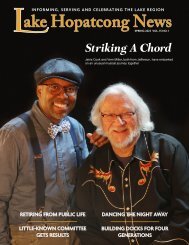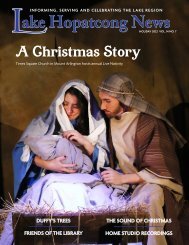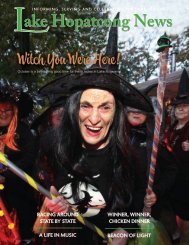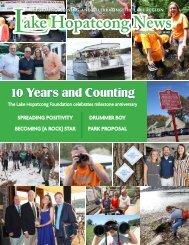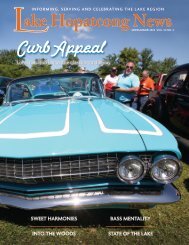You also want an ePaper? Increase the reach of your titles
YUMPU automatically turns print PDFs into web optimized ePapers that Google loves.
April Simnor<br />
keeps an eye on<br />
a pair of Canada<br />
geese as she<br />
checks the eggs<br />
from their nest.<br />
Simnor shares the water with a male<br />
Canada goose.<br />
Homeowners at<br />
Lakeshore Village<br />
install fencing along<br />
the boat launch.<br />
Jamie Brunn and Tena Bos install<br />
fencing at Lakeshore Village.<br />
Solving This <strong>Issue</strong> Can Be<br />
A Wild Goose Chase<br />
They are harassed, their nesting areas<br />
targeted, their eggs addled. Humans<br />
plant taller grass near favored lakes and<br />
streams to deter them or add chemicals or<br />
rough surfaces around water bodies that make<br />
walking to lakes and streams uncomfortable.<br />
Feeding them on public property is illegal<br />
in the four Lake Hopatcong towns—Mount<br />
Arlington banned feeding them on public and<br />
private property.<br />
But Canada geese never seem to go away.<br />
Not for lack of trying.<br />
This year the Lake Hopatcong Commission<br />
will jump into the fray to make the watershed<br />
uncomfortable for the Canada goose, a large<br />
(average weight 12 to 14 pounds, with a 4- to<br />
6-foot wingspan), protective, aggressive and<br />
omnipresent bird.<br />
The birds are both an important member of<br />
the Lake Hopatcong wildlife community and<br />
an identified nuisance whose feces foul parks,<br />
playing fields and beaches and add to the<br />
collective pollution that plagues the lake.<br />
Wildlife professionals have identified<br />
two groups of Canada geese in New Jersey:<br />
Migratory birds that move between breeding<br />
grounds in Canada and overwintering areas<br />
in the United States, and a resident group that<br />
has grown since the 1930s, when they were first<br />
released.<br />
A 2012 Rutgers University Cooperative<br />
Service study noted there were 80,000 native<br />
6<br />
Story by MICHAEL DAIGLE<br />
Photos by KAREN FUCITO<br />
LAKE HOPATCONG NEWS <strong>Memorial</strong> <strong>Day</strong> <strong>2022</strong><br />
Jersey geese. In 2008, there were an estimated<br />
3.6 million resident geese in the United States.<br />
The study said “The overabundance of<br />
resident Canada geese in the eastern U.S.<br />
has significant negative impacts on both<br />
ecosystem and human health. Intolerable<br />
levels of negative human-goose interactions,<br />
including agricultural damage, habitat<br />
degradation, aircraft strikes and environmental<br />
contamination, make managing resident goose<br />
populations a necessity. A lack of natural<br />
predators and high-quality food resources have<br />
greatly increased survival.”<br />
And, oh, both groups of geese—the migratory<br />
and the resident—are federally protected.<br />
Karen Porfido of Mount Arlington, an<br />
alternate on the Lake Hopatcong Commission,<br />
is heading up that group’s new effort to reduce<br />
goose damage to the lake watershed.<br />
She said the impact of goose feces on Lake<br />
Hopatcong is profound.<br />
“Four adult geese can produce as much<br />
phosphorus as one septic system,” she said.<br />
“One goose produces one half pound of<br />
phosphorus a year, which has the potential to<br />
generate 550 pounds of wet algae.”<br />
For comparison, reports filed by Princeton<br />
Hydro LLC, the lake’s water quality consultant,<br />
say removal (through weed harvesting) of one<br />
pound of phosphorus from the lake can result<br />
in the removal of 1,100 pounds of wet plant<br />
material.<br />
Porfido said the commission this year will<br />
begin with an education program designed to<br />
show the impact of the geese on the lake and<br />
to outline preferred discouragement methods.<br />
One goal is to secure permission from<br />
property owners to allow volunteers next spring<br />
during breeding season to enter properties and<br />
addle eggs.<br />
The goose battle is not new nor confined to<br />
Lake Hopatcong.<br />
At Lake Shawnee, Jefferson Mayor Eric<br />
Wilsusen, who is also president of the private<br />
Lake Shawnee Club, said, “We have tried<br />
everything.”<br />
That included egg addling, pyrotechnics<br />
and other noisemakers to startle the geese,<br />
planting tall grass near the shore and chemical<br />
treatments.<br />
“It’s important to addle the eggs,” he said. “At<br />
times we had to close beaches because of the<br />
mess.”<br />
The 83-acre lake is home to 2,559 residents<br />
whose activities rely on access to clean beaches<br />
and a clean lake.<br />
The lake averages 12 to 15 pairs of geese,<br />
Wilsusen said, but has been home to as many<br />
as 25 pairs.<br />
“We have to find a balance that protects the<br />
geese and keeps the lake clean,” he said.<br />
There’s also this: “We are the headwaters for<br />
Lake Hopatcong,” Wilsusen said. “What we do<br />
in Shawnee has an impact in Lake Hopatcong.”<br />
The Lake Mohawk Country Club, a private<br />
lake community in Sparta and Byram, extends<br />
its mitigation efforts to all waterfowl, said<br />
engineer Sabina Watson.<br />
The program includes the usual efforts: Egg<br />
addling, no feeding of birds and other wildlife,<br />
habitat disruption and eradication.<br />
The community of 9,916 people on the 800-<br />
acre lake shares the space with about 30 pairs of<br />
geese, Watson said. The aggressive mitigation<br />
has meant “we have not seen an increase in the<br />
population of geese,” Watson said.<br />
Netcong partners with the Lake<br />
Musconetcong Regional Planning Board and




